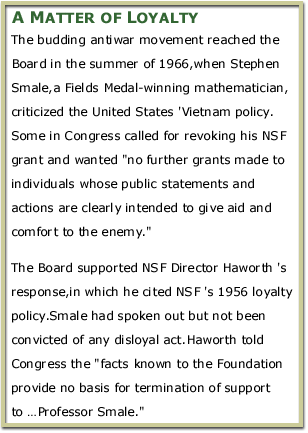
Strengthening White House Science
 The frightening uncertainties of the Cold War triggered a spurt of new federal R & D programs and the
need to coordinate them. Right after Sputnik, President Eisenhower appointed a Special Assistant for
Science and Technology (later called the Science Advisor), the President's Science Advisory Committee
(PSAC), and created an interagency Federal Coordinating Council for Science and Technology.
The frightening uncertainties of the Cold War triggered a spurt of new federal R & D programs and the
need to coordinate them. Right after Sputnik, President Eisenhower appointed a Special Assistant for
Science and Technology (later called the Science Advisor), the President's Science Advisory Committee
(PSAC), and created an interagency Federal Coordinating Council for Science and Technology.
Seeking even greater central coordination, in 1961 Senator Henry Jackson (D-WA) recommended that Congress create an Office of Science and Technology in the White House. "The undischarged planning and evaluation responsibilities of the NSF," he wrote, should be transferred to the new office.
The Board responded by appointing a committee under William O. Baker of Bell Laboratories. Baker had advised a series of Presidents on classified defense matters; he saw the Kennedy team regularly, and so knew its thinking. Baker's report essentially agreed with Jackson's assessment, arguing only that the proposed Office of Science and Technology (OST) should be placed in the White House under the Special Assistant. OST's job should be to review, coordinate, assess and evaluate the state and conduct of federal science and technology. A small staff of "skillful reviewers" would consider a portion of the national total in any given year, working in small panels and drawing on PSAC's expertise.
Kennedy's aides wanted to make the Foundation more responsive to White House control. BOB officials and newly appointed Special Assistant for Science and Technology, Jerome B. Wiesner, wanted to reduce the Board from twenty-four to twelve members, and to have the Director serve also as Chairman of the Board. In their view, the Board should become an advisory body only and leave the Foundation's management solely to the Director.
Wiesner and two budget officials met with the Board in closed session on March 15, 1962. Board members objected to requiring the Director to serve as Chairman, arguing it was a conflict. Stratton proposed making the Director the Chair of the Executive Committee instead, a compromise that was later accepted. The Board insisted that it needed twenty-four members to represent all regions and institutional types. The question of making the Board merely an advisory group was dropped.
In late March, President Kennedy issued Reorganization Plan No. 2, which created an OST with policymaking and coordinating powers. The Foundation's official authority remained unchanged.
